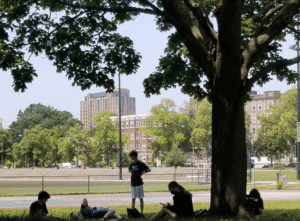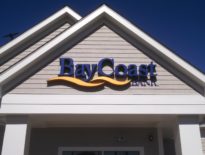
Schoolchildren sit in the shade of a tree by Boston's Clemente Field in the Fenway neighborhood in this undated handout photo. Photo courtesy of the city of Boston
Mayor Michelle Wu announced plans to preserve and expand tree canopies in Boston, including potential new regulations of building designs by the Zoning Board of Appeals.
The city’s new Urban Forest Plan attempts to address the comparative lack of tree canopies in Chinatown, East Boston, Roxbury and Allston-Brighton and negative effects on mental and physical health. With its larger tree canopy, West Roxbury enjoys summer temperatures that are 10 degrees cooler than Roxbury, Wu said.
“It’s due to the choices we’ve made and what infrastructure we build,” Wu said at a press conference this morning at the Arnold Arboretum in Jamaica Plain.
The recommendations include new regulations for building designs that interfere with street tree planting opportunities, such as bay windows and balconies that extend onto public rights-of-way. Landscaping plans should be included in the Zoning Board of Appeals review process, the report states.
As climate activists blocked downtown Boston streets and snarled vehicle traffic to demand stricter fossil fuel regulations, Wu said the initiative “feels like a matter of hope in what feels like desperately urgent times.”
The 237-page plan, the result of recent discussions between the administration and urban forestry advocates, represents a “fundamental shift” in how the city shapes the natural landscape for the next two decades, Wu said.
A new urban forest division in the Parks and Recreation Department will expand the staff from 3 to 16 employees. The administration is accepting applications for a new director of urban forestry, which lists a salary range of $99,405 to $134,729.
Strategies in the report include expanding the tree canopy citywide, new maintenance programs for existing trees on private and public properties, and expanding job opportunities for local residents. In 2021, a team of arborists compiled an inventory the city’s roughly 38,000 publicly-owned street trees.
The new plan includes goals for expanding the number and biodiversity of trees in each of the city’s neighborhoods.
The announcement follows the city’s creation last spring of PowerCorpsBOS, a workforce development program for diverse residents aged 18 to 30. The program will act as a feeder to positions within the new forestry division.
The scarcity of tree canopies, along with extensive blacktop and dark-colored rooftops, has been cited as key factors aggravating urban heat island effects.
Beginning in 2021, Boston officials started asking developers to come up with solutions to minimize urban heat island effects when seeking approval to redevelop surplus properties. The requirement was a key element of the selection criteria for proposals to redevelop the Crescent parcel in Nubian Square.
The Climate Ready Boston study estimated that average summer temperatures in Boston could rise 7 degrees from typical levels in recent decades to 76 degrees by 2050.
A 2019 Urban Land Institute report identified Lower Roxbury, East Boston, Somerville and Chelsea-Everett as the region’s primary heat islands.
If Boston moves to start analyzing landscape plans as part of its approvals process, it won’t be the first Massachusetts community to do so. Some of the region’s wealthy suburbs passed laws in recent years requiring some projects, particularly residential teardowns, to preserve medium- and large-sized trees already on-site instead of cutting them down to improve access to a building during construction.




 |
| 



